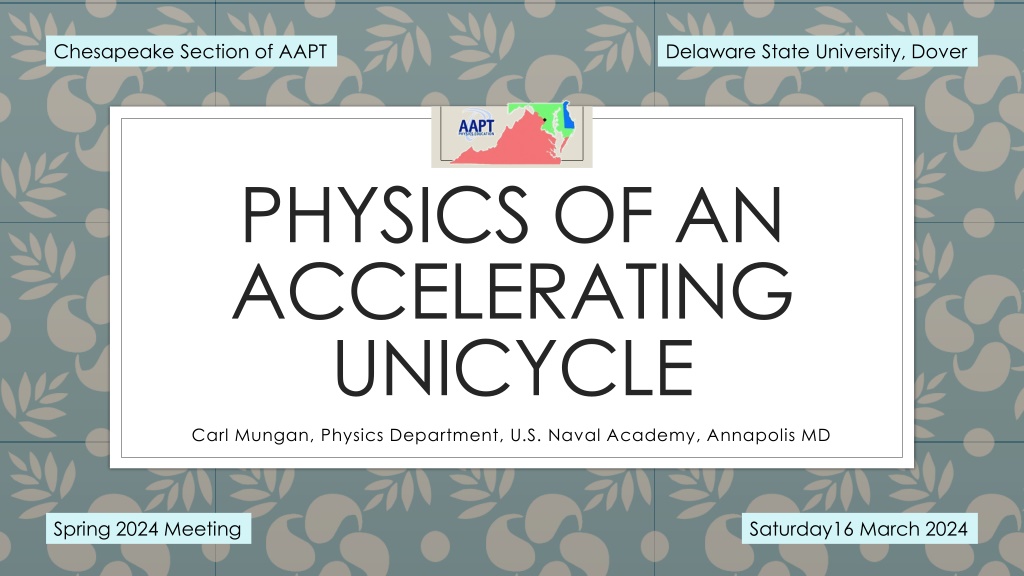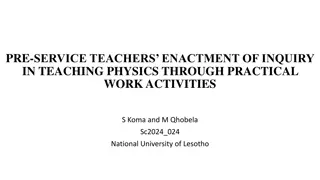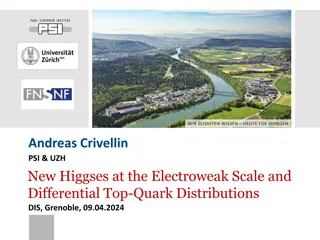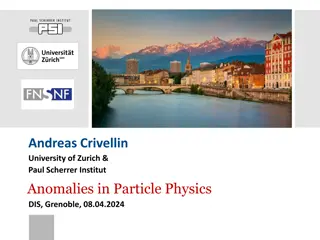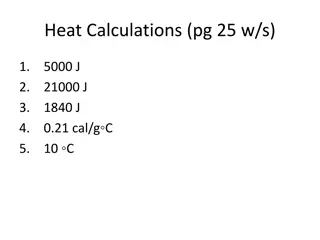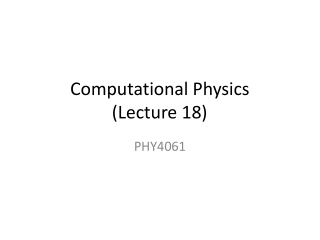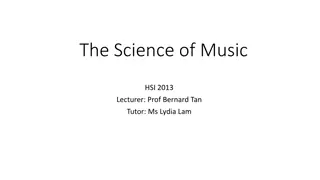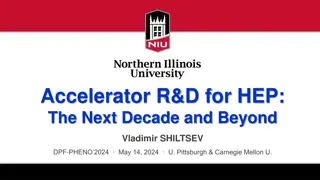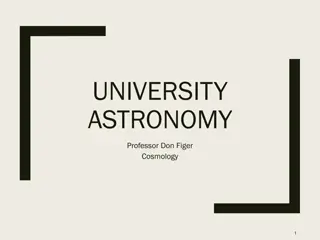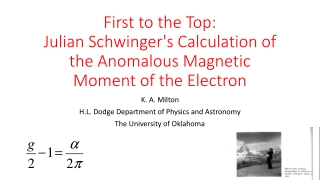Understanding the Physics of an Accelerating Unicycle
Explore the intriguing concept of an accelerating unicycle in the field of physics, diving into topics such as static friction, rolling motion, and torque analysis. Discover how the interplay between forward translational acceleration and angular deceleration affects the dynamics of a unicycle, with practical examples and explanations provided.
Download Presentation
Please find below an Image/Link to download the presentation.
The content on the website is provided AS IS for your information and personal use only. It may not be sold, licensed, or shared on other websites without obtaining consent from the author. Download presentation by click this link. If you encounter any issues during the download, it is possible that the publisher has removed the file from their server.
Presentation Transcript
Chesapeake Section of AAPT Delaware State University, Dover PHYSICS OF AN ACCELERATING UNICYCLE Carl Mungan, Physics Department, U.S. Naval Academy, Annapolis MD Spring 2024 Meeting Saturday16 March 2024
A ball rolls along a ramp without slipping. (Neglect air drag and rolling friction throughout this talk.) Why doesn t the ball slide instead of rolling? Answer: Because of static friction. Let s see how that works by drawing a FBD.
(regardless of whether the ball is moving up or down the ramp)
Does f = N where is the coefficient of static friction? Hopefully not, because otherwise the ball will be about to slip. Specifically suppose is small enough and large enough that tan < to avoid that. In that case, how do we find an expression for f ? Answer: We need it to get so use N2L.
= sin Mg f Ma translations of O: 2a = MR = Ma rotations about O: fR f R = + sin (1 ) M g M a add the two equations: sin 1 + g sin + Mg = = and a f 1 2 5 1 2 = e.g. for solid sphere or for uniform disk (rolling object of radius R)
sin 1 + sin + g Mg = = and a f 1 Now let = 0 so we re on a horizontal surface. Then f = 0 ! Does that mean it cannot roll without slipping? Answer: No, but a = 0 and = 0 so it must be rolling at constant translational speed and angular speed with = R .
But what if we want to speed up or slow down the rolling? Good question! As an example of a single-wheeled object that can increase in speed, consider a unicycle. There must now be a forward static frictional force to produce the forward translational acceleration. But the frictional torque then tries to angularly decelerate the wheel. Thus the driving torque applied by the rider must be opposite in direction and larger in magnitude than it.
partial FBD: We re missing the rider! Model him as a point mass m at radial distance r.
Includes the seat, support rod, and rider. Smartphone running Phyphox to measure acceleration.
FBD: for rider alone for whole system for wheel alone Equal & opposite F and as on the wheel by N3L. Rider is accelerated forward by Fx and must tilt to counter . Rider must tilt forward by to accelerate forward as panel (c) shows. Rider applies driving torque and reaction force F to the wheel.
Apply N2L for translations and rotations both to the wheel alone and to the rider alone. Use small-angle approximation for . (Details in upcoming paper in Physics Education.) / R + acceleration of unicycle: = a + (1 ) m M tilt angle to balance torques on rider: 1 1 + = + + (1 ) g mr mR MR + / Rg + frictional coefficient to avoid slipping: (all three are proportional to the applied torque) = min (1 ) m M
Compare theory to experiment Variable Value 6.0 kg M 65 kg m 0.90 0.38 m R 1.1 m r 9.8 N/kg g
Accelerating by tilting 15 and then returning to constant velocity: (Ph.D. student Heiko Kabutz at Univ. of CO Boulder)
Measured acceleration in blue versus theoretical peak acceleration in green:
More detailed comparison from video analysis of tilt and displacement: (used Tracker to measure coordinates of axle and of seat)
Comments or questions? email: mungan@usna.edu webpage: usna.edu/Users/physics/mungan
